
I was recently contacted by a small group of women who had been involved in leaving ‘adult human female’ postcards around Brighton and taking photos of them. This is their story. Names have been changed and randomly assigned.
Many of you will know Brighton, a fashionable seaside resort on the South coast, once known for its lesbian and gay community, now the very heart of British ‘queer’ culture and probably the wokest town in England. ‘Trans Rights’ stickers are everywhere and everything is ‘queer’. Think I’m exaggerating? Here’s a picture of Brighton Marks & Spencer.
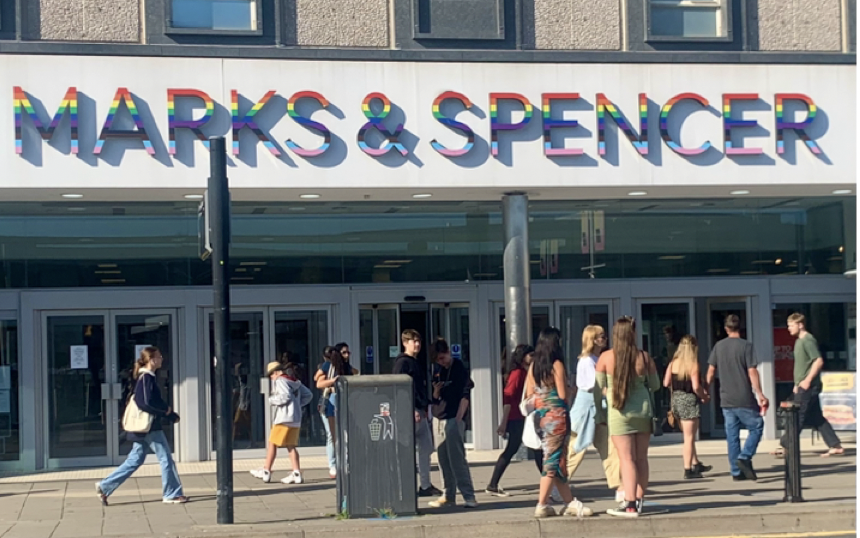 Is there much of an actual gay scene, or has it all been overrun by trans, drag and kink? I type ‘lesbian bars in brighton’ into Google.
Is there much of an actual gay scene, or has it all been overrun by trans, drag and kink? I type ‘lesbian bars in brighton’ into Google.
“Take a look at our top picks of the best lesbian bars in Brighton!” chirps website ‘design my night‘. That sounds positive.So I do.
The Charles Street Tap, described as “one of Brighton’s most popular lesbian bars” hosts frequent ‘drag’ nights, and has even replaced the ‘Ask for Angela’ scheme with ‘Ask for Clive’. So if you’re a fan of men with fake breasts & sparkly dresses  mocking women, get yourself down there.Yay.
mocking women, get yourself down there.Yay.
The Queen Anne’s Arms is also on the list of ‘lesbian bars’ yet is also described as ‘something of a drag staple’.
In another article on lesbian bars in Brighton, the ‘HER’ dating ap- known best for barring a lesbian who dared to put ‘biological women only’ in her bio- ironically laments the loss of lesbian bars while in the same sentence celebrating ‘queer-friendly spaces’. The article observes, ‘Dance club with foam parties? Check. Artsinally (sic) crafted cocktails? Yep, we’ve got those too. Brothels turned queer pubs? Wow! Drag? Of course.”
I mean, what more could a sapphic female want? Other bars are described as ‘very popular among a femme crowd’ or ‘positively queer’. The Marlborough pub, once the meeting place of the Sussex Gay Liberation Front, now renamed ‘The Actors’, is proud to have hosted enby narcissist Travis Alabanza, and the Arcobelino will evidently ‘satisfy every craving your queer heart may desire’.
“What about actual lesbian and bi women?” I hear you ask, to which I reply, “Is that a transphobic dog whistle, bigot?”
It seems the more articles I read about lesbian bars in Brighton, the more certain I become that there aren’t any.
I ask a couple of friends who are actually lesbians. Sarah is in her early twenties and has lived in Brighton for four years.
“I don’t think there are any,” she muses. “There’s Velvet Jacks but it’s an older scene and I think technically still marketed as an LGBTQ+ bar not a lesbian bar. Yeah, definitely no LESBIAN bars in Brighton.”
Juliet is in in her mid fifties. “I used to go to The Malborough pub quite a bit for quite a few years. It was a lesbian pub with not a tranny in sight.”
“Hmm. I’m not sure I can put that,” I told her.
What about gay bars for men? Well, it seems much the same. Most bars are ‘queer’ and LGBTQIA+ friendly’. Drag is ubiquitous and everybody simply has to love it, dahhhling: the elaborate religious ceremony of the queer movement. Drag, drag, drag.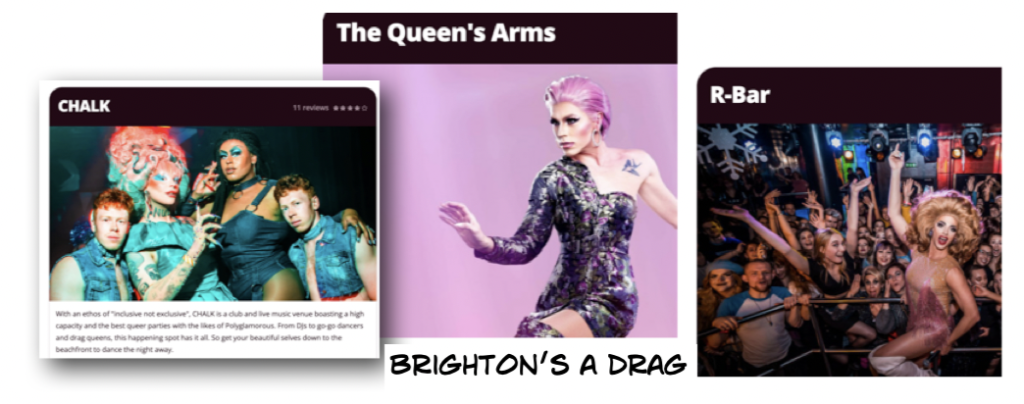
It seems that Brighton, wokest of the wokedoms, doesn’t actually have any gay bars. Now that’s what I call progress.
Coals to Newcastle
 You might be forgiven for thinking that a holiday resort like Brighton was not in need of any more postcards. The group of women I spoke to thought otherwise. Overwhelmed by the woke on every corner, they had decided to bombard Brighton with Adult Human Female postcards.
You might be forgiven for thinking that a holiday resort like Brighton was not in need of any more postcards. The group of women I spoke to thought otherwise. Overwhelmed by the woke on every corner, they had decided to bombard Brighton with Adult Human Female postcards.
“Initially it was going to just be the museums, then we thought we’d add some postcard stands,” Serena told me. “Then someone suggested bookshops and we thought ‘why not?’ There were enough of us that we managed to do it all in one day.” she chuckled. “They’ll be turning up for months!”
I asked where they had left the cards.
“Where haven’t we left them! We started at the Brighton Museum and Art Gallery. I go there quite often because you buy a ticket once and it lasts for a whole year, but you don’t need a ticket to go into the gift shop, so in we all piled in together. There were several postcard carousels, so we left our own postcards on each. There was the predictable stand of ‘queer’ books, so we also slipped a few postcards inside some of those.”
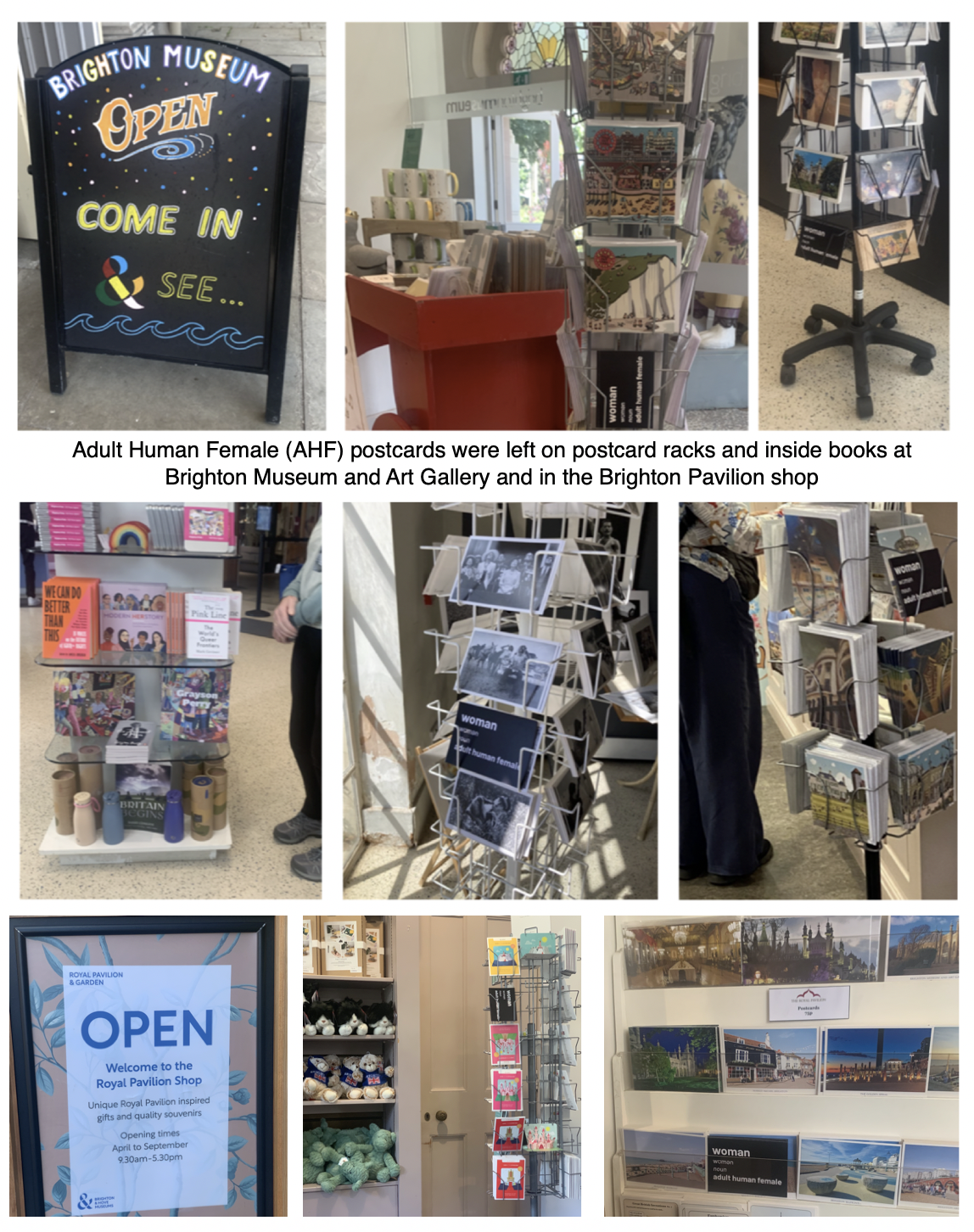 After that we moved on to the Pavillion gift shop. It’s a beautiful big space with loads of trinkets, books and niknaks. Really worth a visit. I leisurely browsed the colorful array of postcards, each one telling a story of its own. It was easy to slip some extra cards, with our own message, among the ones on display.”
After that we moved on to the Pavillion gift shop. It’s a beautiful big space with loads of trinkets, books and niknaks. Really worth a visit. I leisurely browsed the colorful array of postcards, each one telling a story of its own. It was easy to slip some extra cards, with our own message, among the ones on display.”
“It was a sunny day, and we strolled through the town on our mission to spread the message of reality and sisterhood through postcards of resistance!” Elspbeth told me.
“We are adult human females, we are women! It was Pride week (or was it – is every week Pride week now?) We, the women, whether heterosexual, lesbian or bisexual, faced an onslaught of so called ‘progress flags’ at every turn. It was overwhelming – hanging above us and displayed in many shops. A few of the original rainbow flags fluttered forlornly in the breeze, vastly outnumbered. I wonder how much longer that will be allowed?

In the many shops that we visited there was more of the same. There was no escape from the relentless tide that has flooded the town. But we were able to leave our message without challenge. After all, we are the invisible women.”
“”I felt on edge walking through town,” Melissa told me. “It was hard to avoid seeing the so called ‘Progress’ Pride flag, which to me is anything but progressive. It feels oppressive as it suggests that you are not welcome if you don’t subscribe to that belief system. I never felt that from seeing the original LGB Pride flags.”
Beside the seaside
After the women had visited the Pavillion gift shop and the Gallery and Museum, they decided to pay a visit to the pier for some fresh sea air and ice cream. There they left postcards in the photo booths and the amusement arcade, as well as on postcard stands and in the Ladies toilets.
“One of the grabber machines was full of adorable fluffy dinosaurs. Of course, we had to leave a postcard there!”
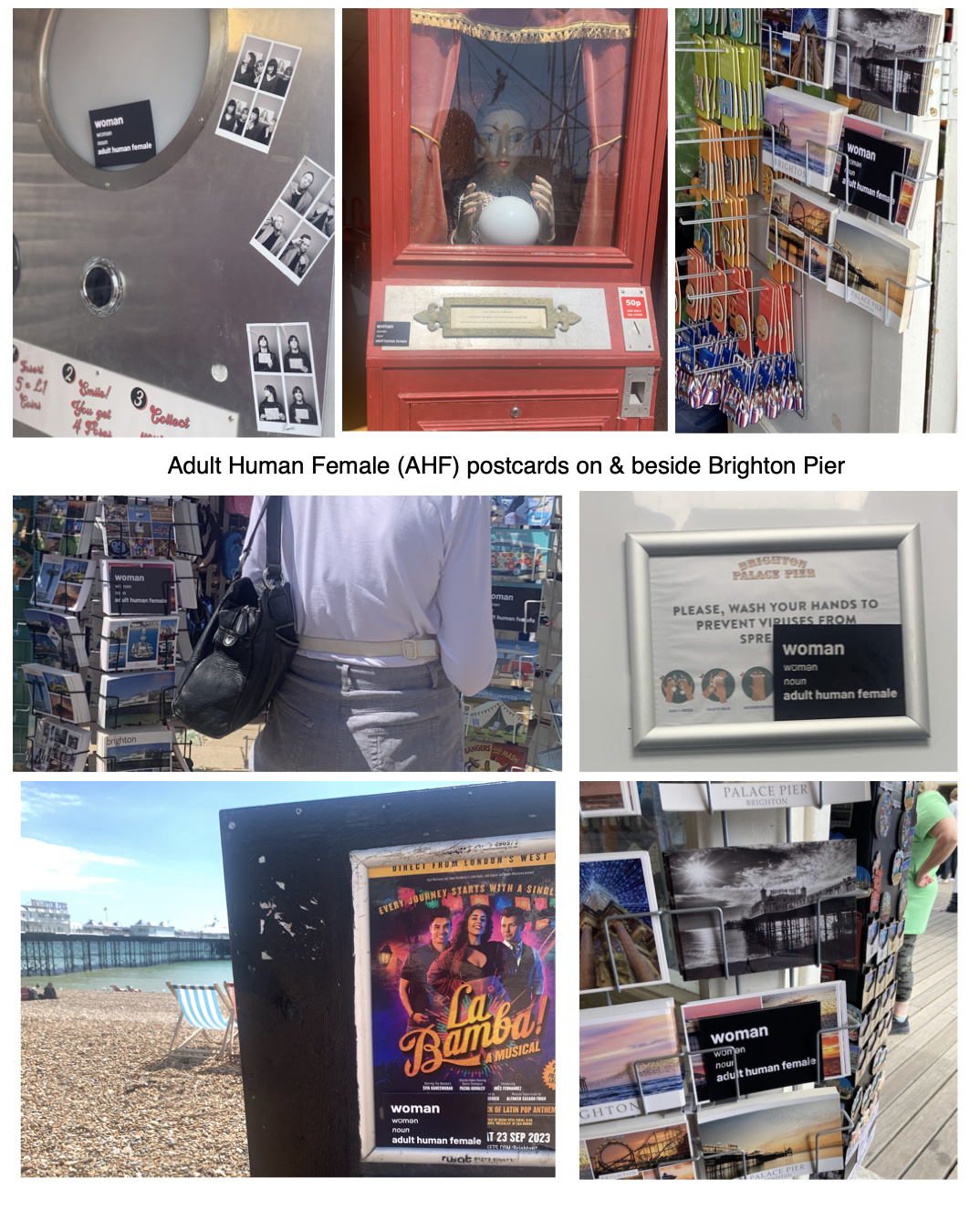
Shall we promenade?

“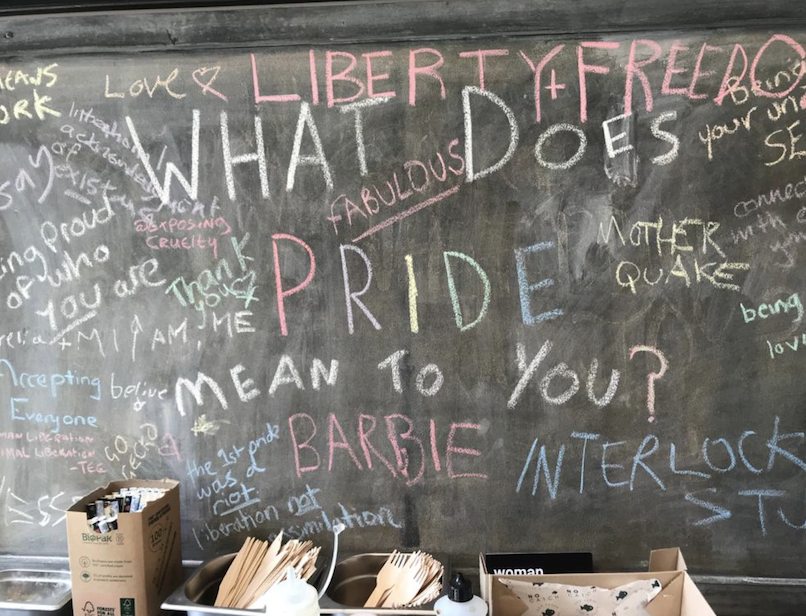 It was a really hot day,” remembers Serena,“and by then we were getting hungry and thirsty. A few of us were vegetarian or vegan so we made our way to ‘No Catch’ which does the most amazing fake fish.
It was a really hot day,” remembers Serena,“and by then we were getting hungry and thirsty. A few of us were vegetarian or vegan so we made our way to ‘No Catch’ which does the most amazing fake fish.
Some of the others were having none of that, so had lunch at an actual fish and chjp shop on the next block. Even in the chip shop we weren’t free of the endless obsession with all things ‘queer’. But the food was delicious & we left them a little gift as well as a tip. Can you spot it?”
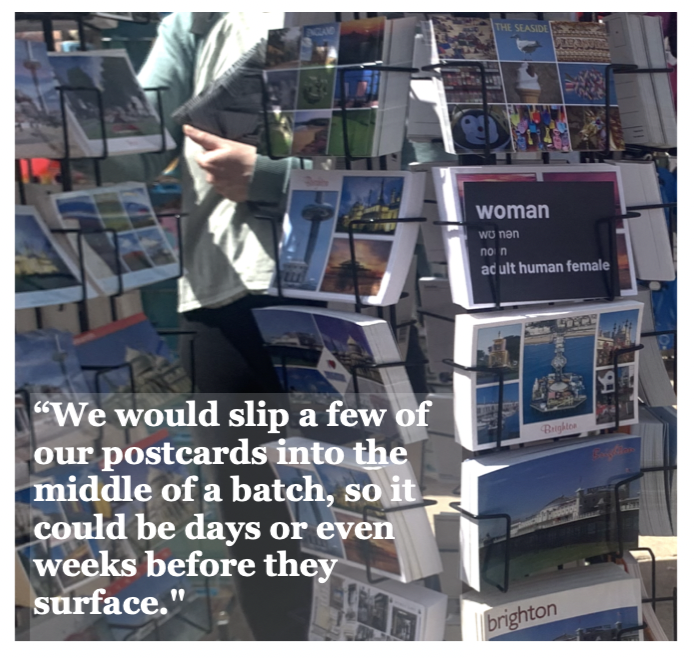
The i360
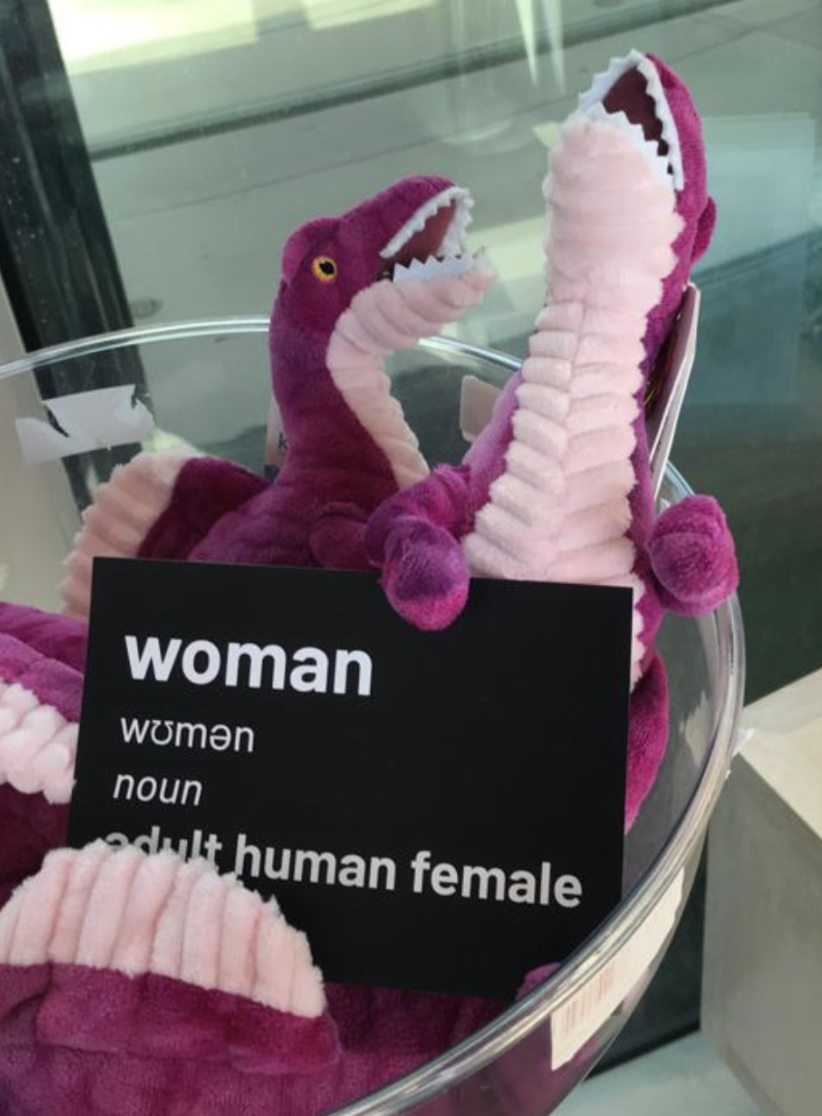 The i360 is a spectacular tower rising proudly over both the sea and the town or a hideous phallic eyesore, depending on your perspective. Overlooking the remains of the old West Pier, it reaches a giddy height of 162 metres and from the top you can see as far as the South Downs. A trip to the top will cost you a cool £18, but the i360 didn’t open until 2016 and, as such, provision was made for a vast giftshop on the ground floor which is free to visit.
The i360 is a spectacular tower rising proudly over both the sea and the town or a hideous phallic eyesore, depending on your perspective. Overlooking the remains of the old West Pier, it reaches a giddy height of 162 metres and from the top you can see as far as the South Downs. A trip to the top will cost you a cool £18, but the i360 didn’t open until 2016 and, as such, provision was made for a vast giftshop on the ground floor which is free to visit.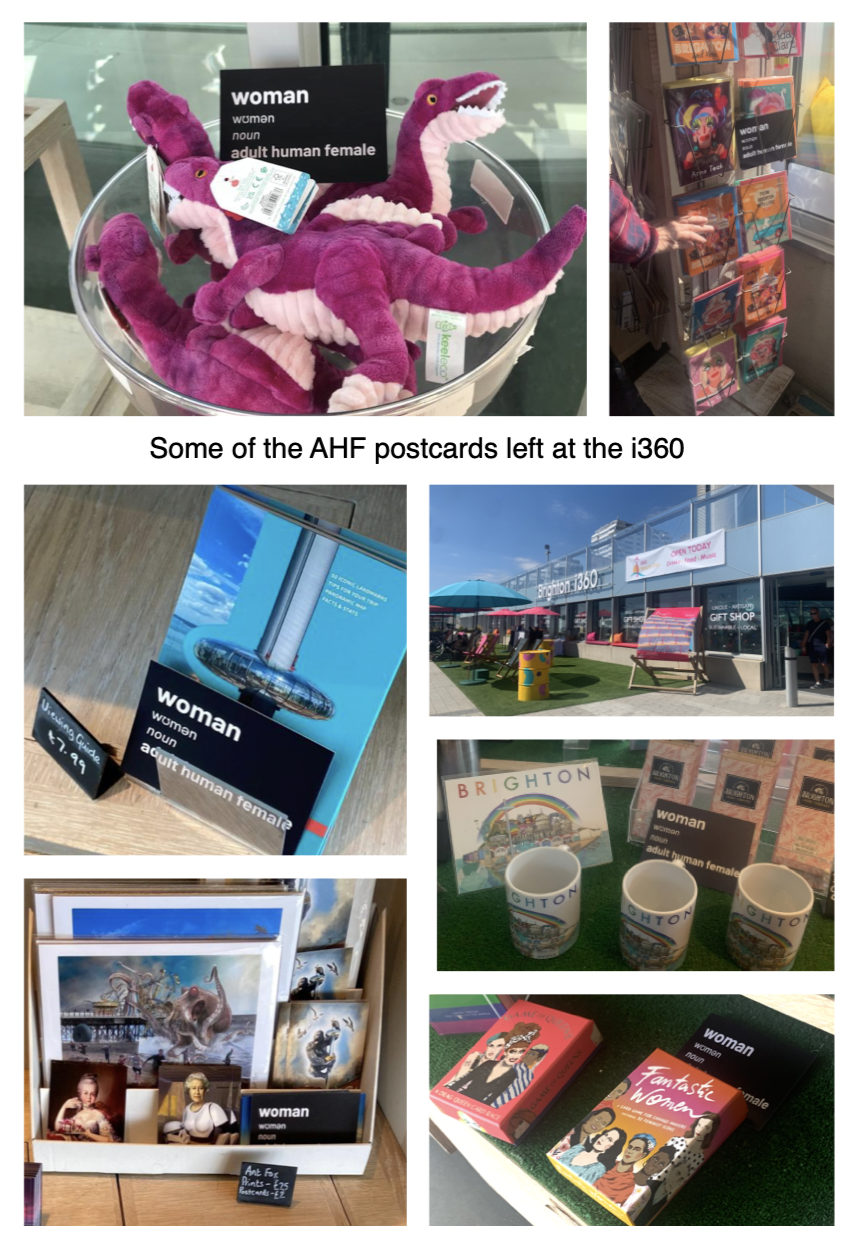
Having visited a variety of galleries, gift shops and tourist shops, the women decided to drop in on some of Brighton’s many bookshops.
The Feminist Bookshop

The Queery
Oxfam
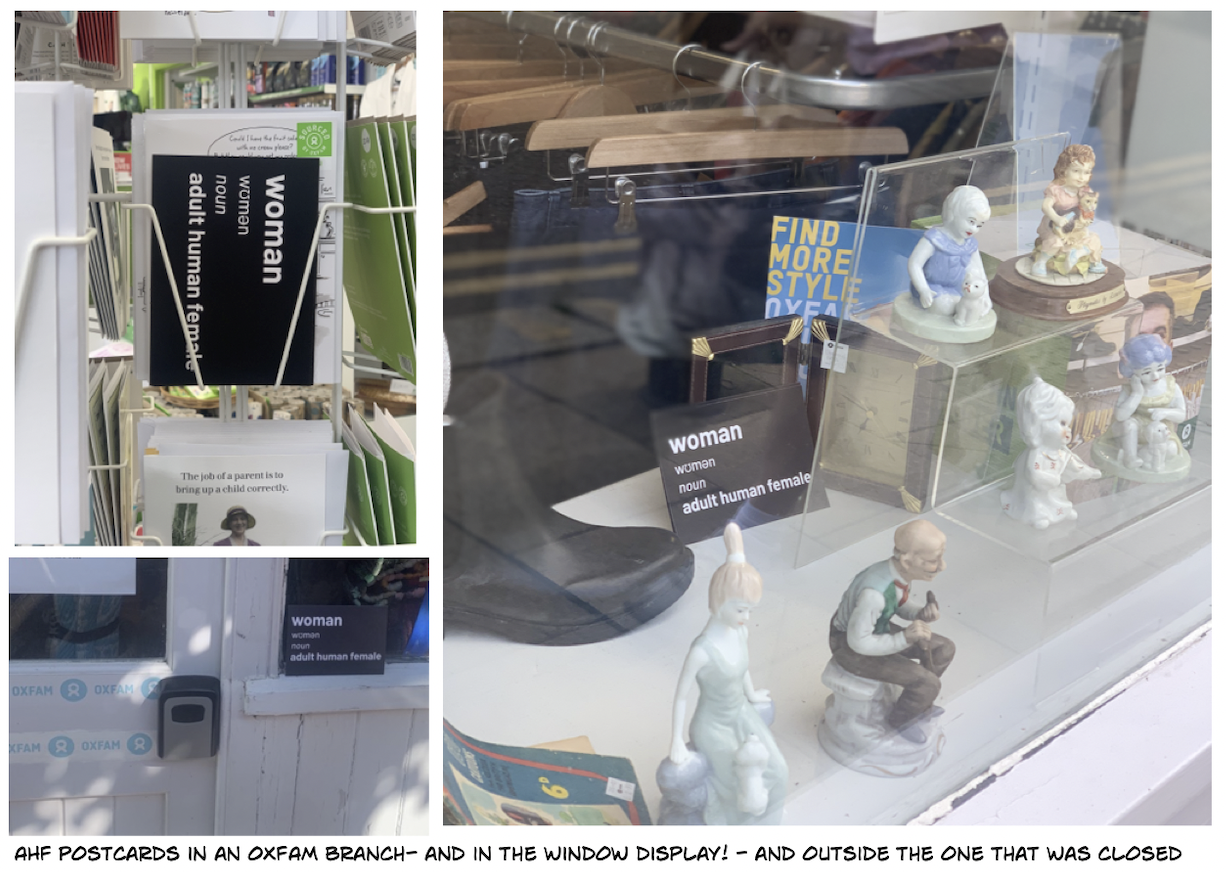
Waterstones

Melissa and three of the other women made their way to ther children’s department.
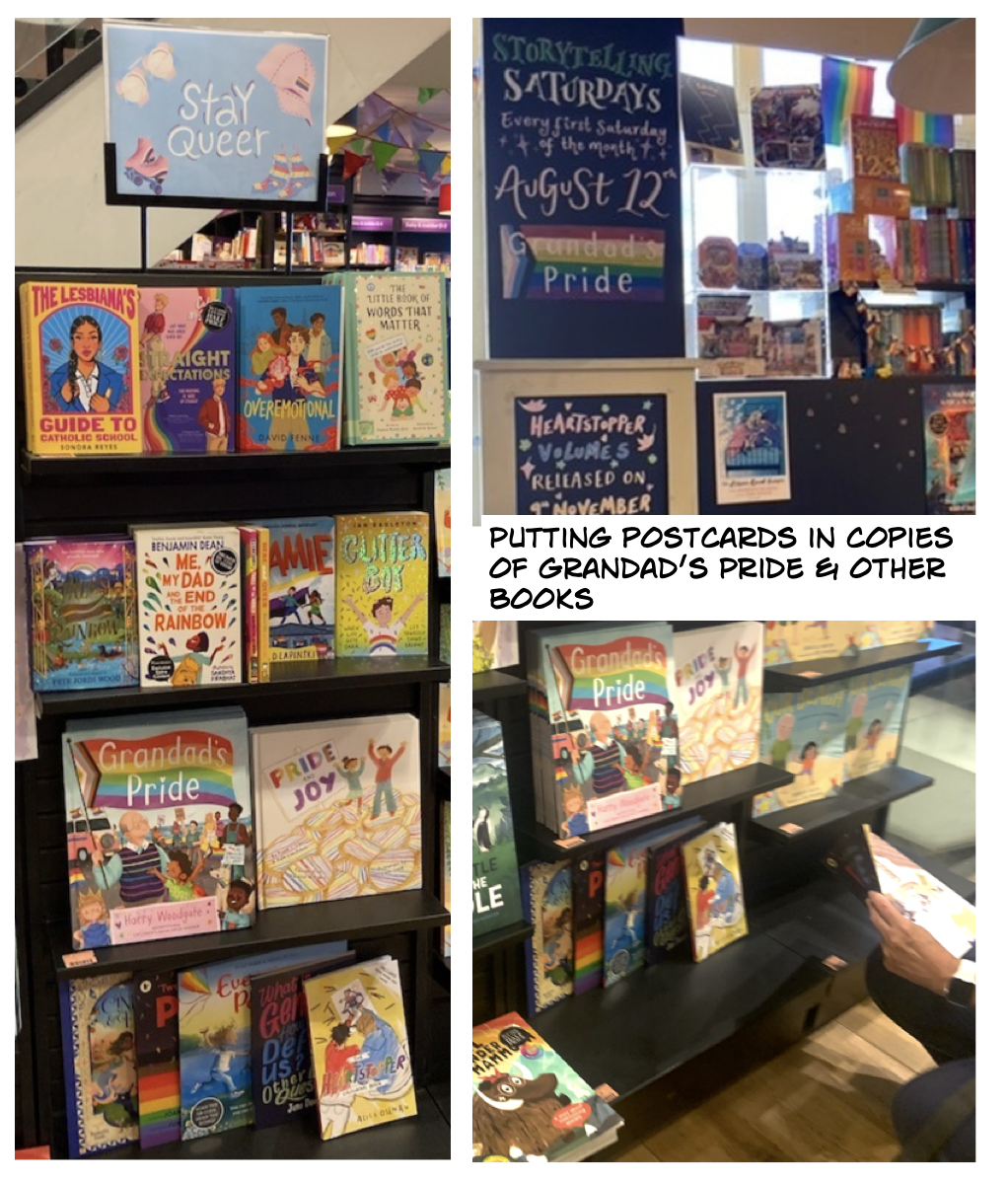 “I was shocked to see a ‘Stay Queer’ stand and numerous books promoting it.” Melissa told me.
“I was shocked to see a ‘Stay Queer’ stand and numerous books promoting it.” Melissa told me.
“It was even worse to see that Grandad’s Pride was the storytime book of the month to be read to children.
I would have liked to see the looks on parents’ faces as the pictures showed the man in bondage fetish gear or the young woman with mastectomy scars – did they smile and nod along as if this was fine to show their children?”
If you’re finding all of this a bit excessive and thinking, “what’s the harm in a book called Grandad’s Pride, good grief give the old bloke a break,” let’s be very clear here: celebrating gay (or presumably bi) grandads is great, yay, go for it. At least half the women that took part in this action are lesbian or bisexual. Grandad’s Pride is not of the perfectly reasonable ‘some kids have two daddies – or two grandads’ school of ‘love is love’. Grandad’s Pride is a vehicle for ‘queer’ propaganda, a safeguarding nightmare- a kids’ book which promotes BDSM and endlessly parrots the line ‘love is love is love’ along with other gems like ‘smash the CIS-tem’, ‘protect trans kids’ and ‘trans kids are magic’. It features a beardy bloke dressed in bondage gear and leather knickers, a ‘non-binary’ baker, a young woman who has removed her breasts, drag queens and of course – trans kids. We learn very little about grandad’s lost love but we do learn a lot about ‘being trans’. Here are some photos of illustrations: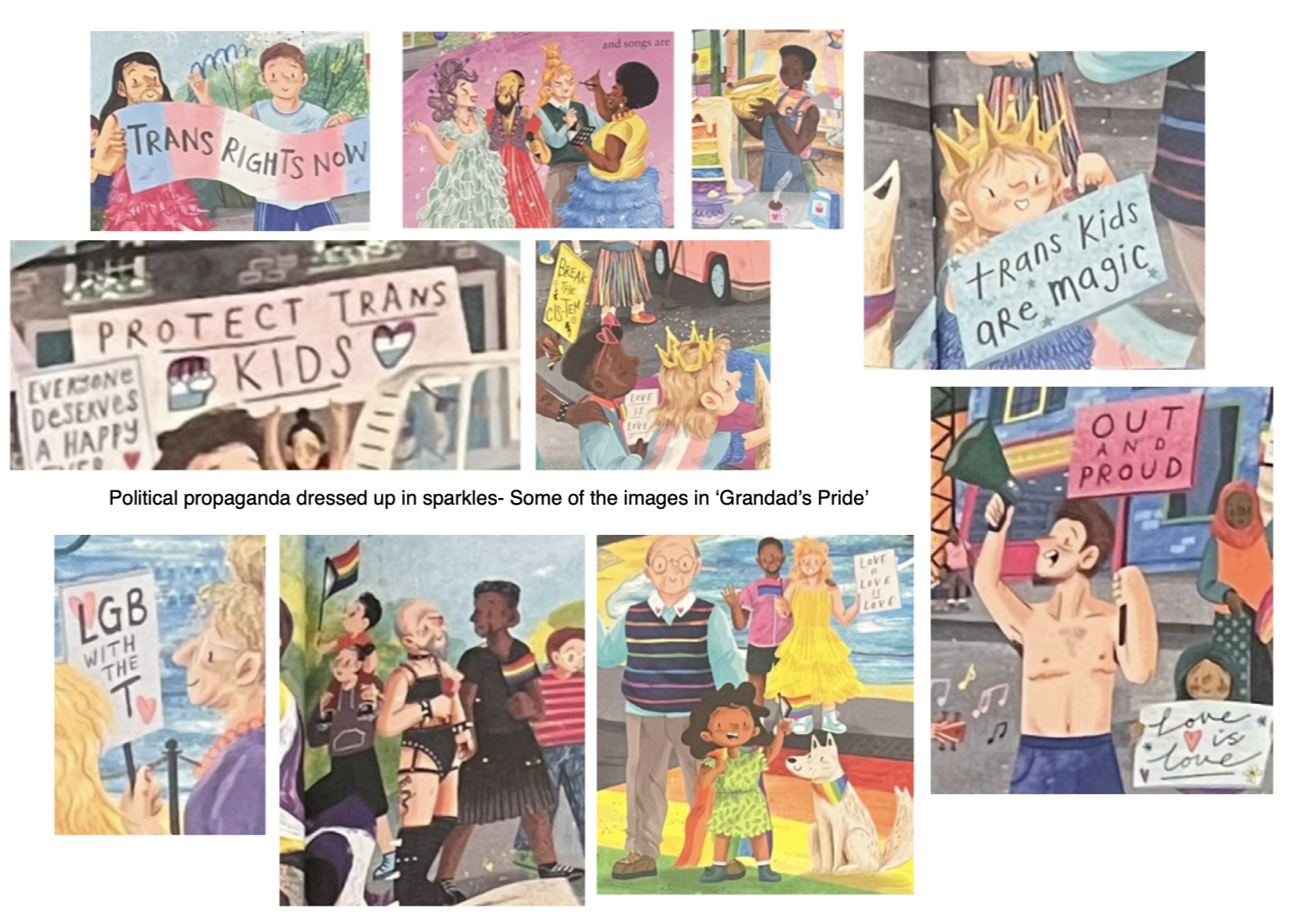
In the story, Millie visits her grandad and discovers his old Pride stuff in a trunk in the attic. Grandad’s trunk contains a pair of ‘Lolita’ sunglasses, a prominently featured ‘MAP,’ a polaroid camera, such as might be used to take ‘secret’ photos, and the slogan ‘love is love is love’ a phrase often associated with the paedophile movement. These things may all be complete coincidences, but it seems a little strange that someone compiling the collection of objects to appear in grandad’s trunk might not have made such a connection. Many believe that these are ‘easter eggs’, put there on purpose in a way that is easily deniable but signals to those ‘in the know’. At this point I just don’t know what to believe.

Grandad’s Pride wasn’t the only book pushing ‘trans’ woowoo onto kids. ‘You Grown Girl’, ostensibly a book for pubescent girls, about learning to love and look after your body, features a picture of a girl wearing a breast binder, not only within the pages but on the cover. Copies of ‘You Grow Girl’ were also treated to a postcard, slipped in on the appropriate page, as were various kids picture books featured in the Pride display.

 “I was in the kids’ section of Waterstones for ages,” Melissa told me. “I just kept finding more copies of books I wanted to leave a postcard in! The others wondered what had happened to me: in the end Serena had to come and get me.
“I was in the kids’ section of Waterstones for ages,” Melissa told me. “I just kept finding more copies of books I wanted to leave a postcard in! The others wondered what had happened to me: in the end Serena had to come and get me.
I think the thing that struck me most forcibly about the day was when I saw a charity shop for children with disabilities. I realised that it was the first time all day I had seen anything about any other ‘protected characteristic’. The absence of focus on disability awareness and support was stark. Given the very tangible vulnerability and economic struggles faced by many people with disabiliities it underlined the lip service paid to ‘diversity, inclusion and equality’.”
“I left Brighton with a mixture of feelings about the town,” Mia, who doesn’t live in Brighton, told me. “I remembered those distant days when Brighton held a positive meaning for me. It had been somewhere I felt comfortable and safe. I had enjoyed Brighton Pride at that time. I had known lesbians who had moved to Brighton and thought that I might one day do the same. I could never have imagined the contrast between the Brighton of my past and Brighton today.”
“Still, undeterred we left our important messages of resistance,” added Elspbeth. “It was good to meet up at the end of the day and share our experiences, Solidarity and sisterhood with women who are grounded in reality!”
“It was fun,” reflected Erin. “I was meeting up with women I only knew from WhatsApp and Signal groups. A bit like being in the French resistance, I only know first names and no addresses!”
” I love to think of those postcards surfacing all over town, days, weeks, months later,” concluded Serena. “The message is so powerful and simple which is why it has become iconic. The no-nonsense writing on the plain black background. Nobody can argue with it really! It’s so simple, we all know a woman is an adult human female yet people will tie themselves in knots trying to make sense out of denying it.
We’ll definitely do it all again in a couple of months.”



